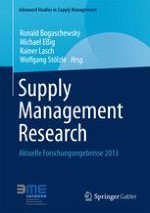Der sechste Band „Advanced Studies in Supply Management“ stellt wissenschaftliche Fortschritte in den Bereichen Einkauf, Materialwirtschaft, Supply Chain Management und Logistik vor. Er ist zugleich Tagungsband des an der Universität Würzburg durchgeführten „ 6. Wissenschaftlichen Symposiums Supply Management“. Wissenschaftliche und anwendungsorientierte Beiträge fördern die qualifizierte Auseinandersetzung im Themenbereich und befruchten den Dialog zwischen Wissenschaft und Praxis. Präsentiert werden u. a. Arbeiten zum Verhalten in Kunden-Lieferanten-Beziehungen, zu Lieferanteninnovationen, zum Komplexitätsmanagement in der Beschaffung und zu Nutzenpotenzialen von Social Media.
